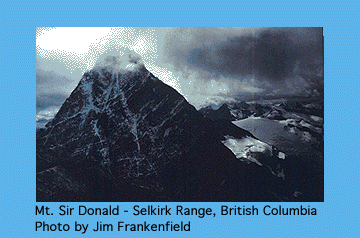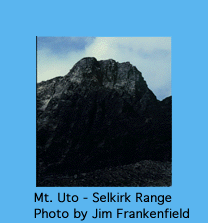Selkirk Mountains, BC - Rogers Pass Region - Sir Donald Range
Mount Sir Donald - 3297 m - NW Ridge - III, 5.2, ****
Uto Peak - 2932 m - SW Ridge - II, 5.1, ***
Wheeler Hut (Trailhead) - 1250 m
 August 1995. I had been planning on a climbing trip to Canada for months, ever since a friend in Salt Lake City had called and asked if I was interested in climbing Mt Robson. August 1995. I had been planning on a climbing trip to Canada for months, ever since a friend in Salt Lake City had called and asked if I was interested in climbing Mt Robson.
The trip had changed over the intervening time. The group from Salt Lake was going too early for me to join them, and probably too early to have good weather and safe climbing conditions. Then I had planned to meet some climbers from New Hampshire to do another climb in the Rockies, but when they changed their objective I lost interest.
And so I set off for Canada alone with no particular plan, reading the guidebook along the way. When I read the description of Mt Sir Donald it sounded pretty appealing. Long. Alpine. Aesthetic. Technically straight-forward but with lots of exposure. The perfect route to solo!
I arrived at the Wheeler Hut by Rogers Pass late in the day. Wanting to warm up and stretch my legs, check out the approach, and get a feel for the climbing, I got up early the following morning and climbed Uto Peak. I was slow getting to the Uto-Sir Donald col, but felt good on the climb. There had been snow up high recently and I did encounter a few patches of the lichen this area is known for - when its wet it is like motor oil on the rock.
The summit register on Mt Uto was filled with entries by people who had come to climb Sir Donald but had been unable to due to weather.
The picture of Sir Donald on this page was taken from the summit of Mt Uto. The grand North Face is visible (first ascent by Chouinard and Beckey in August, 1961). I climbed the NW Arete, which forms the right skyline.
The following day I took a rest at the Wheeler hut. It seems that everyone who stays there brings/cooks too much, so I ate rather well. I enjoyed speaking with a Canadian guide from Nelson BC, Dave Smith, and his friend Ole from Denmark. Dave also has a technical interest in avalanches. He was not certain the peak would be dried off enough yet from the last storm. He also wisely suggested I start earlier than the 5am start I had planned.
The next day came and I got started at about 5am. I reached the col in about 3 hrs - average time, and better than on the Uto climb. From the col the arete looks very intimidating and appears to be overhanging in one section. A phrase from the guidebook kept sticking in my mind - "It should be noted that there have been fatalities from unroped falls ...". So it was with a certain amount of intrepidation that I began the climb.
 The climbing was extremely nice - 4th and easy 5th class. The exposure was always there, and despite the ease of the climbing I continued to feel apprehensive. The climbing was extremely nice - 4th and easy 5th class. The exposure was always there, and despite the ease of the climbing I continued to feel apprehensive.
After about two hours I saw two climbers down in the col. I thought they must be climbing Mt Uto since it was getting to be quite late for a start on Sir Donald. But they were indeed climbing Sir Donald, and had even camped up high at the Vaux bivy site.
About two-thirds of the way up I reached the crux of the climb. I mistakenly determined that it was necessary to go out to the right over the abyss of the west face. I traversed out and up into a small roof. The rock was rotten and crumbly and I retreated back to a ledge. This effort had involved considerable risk and had been quite nerve-wracking! Finally I found the best way, close to the ridgeline, and got beyond this. The holds were all there and were all good, but the exposure over the face was incredible.
After this the climb just continued on forever. One spot had a bit of snow to cautiously bypass, watching carefully for any of the motor-oil lichen. I was starting to feel that the downclimb was going to be long, tedious, and psychologically draining.
Finally - the summit! I ate a bit of lunch and watched the swirling clouds, hoping that there would not be any precipitation that day. Then I got prepared to descend.
The descent down the arete can be done by either downclimbing or by many rappels. I find, especially solo climbing, that downclimbing as much as possible speeds things up. So I downclimbed about two-thirds of the arete, rappelling only over the crux. About half way down I passed the other two climbers, who were slowly working their way up.
By the time I got to the bottom third I was getting tired and sloppy. Which worried me. So I began to rappel. There are webbing rappel anchors all over the place, and I had to be careful not to keep getting out into the North Face and away from the arete. The lower I got, and the later it got, the more this all seemed to drag on. And all I had brought for a rope was about 70-80' of 7mm rappel cord, so my rappels were short.
Finally, the col! I had done it!
I looked up and admired the route. It was almost dark and the only flashlight I had was a little pocket plastic thing which lights when you squeeze it in the middle (admittedly poor planning!), so I was going to have to rush and get as low as possible before dark. The other two climbers were rappelling the crux. They were facing either a descent in the dark or a bivy - neither of which I envied. I was able to get most of the way back without a light by making use of the limited ambient light. I returned at probably 10 or 11 pm.
In the morning while I was still in bed in my VW bus, outside the hut, I heard Dave getting ready to set out. He and Ole were going to do Uto and camp at the Vaux bivy site, then do Sir Donald. I told him about the other two climbers, in case they were still up there. But it seems they finished the descent in the dark and had left.
The weather went downhill that morning. By the afternoon I was driving into a raging storm crossing the Canadian Cascades. Surely there would be blizzard conditions up on Sir Donald. I thought about Dave and about Ole, who had waited patiently to get a chance to do the climb. I realized how lucky I had been to have the chance to get in these two climbs.
Jim Frankenfield
| ![]()
![]()